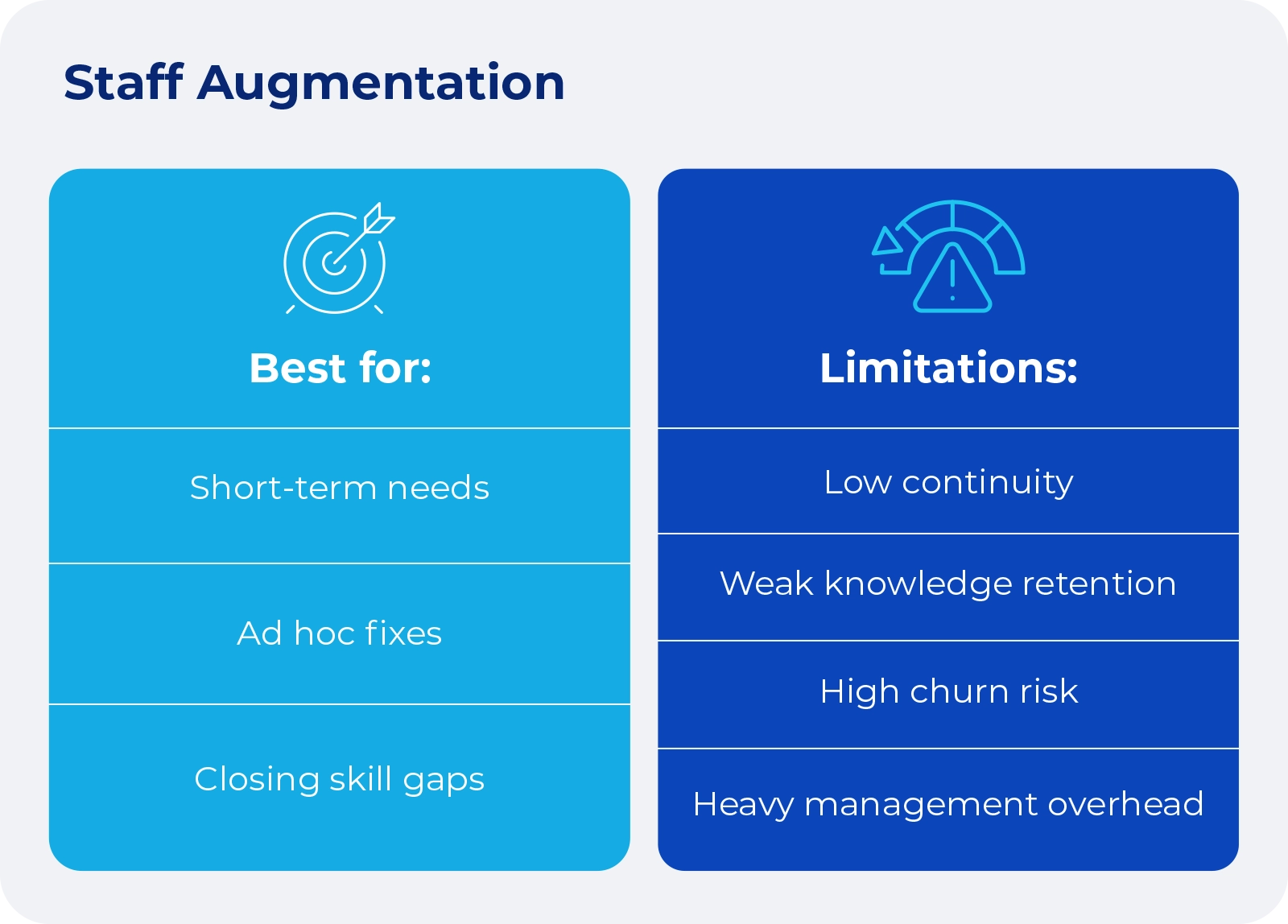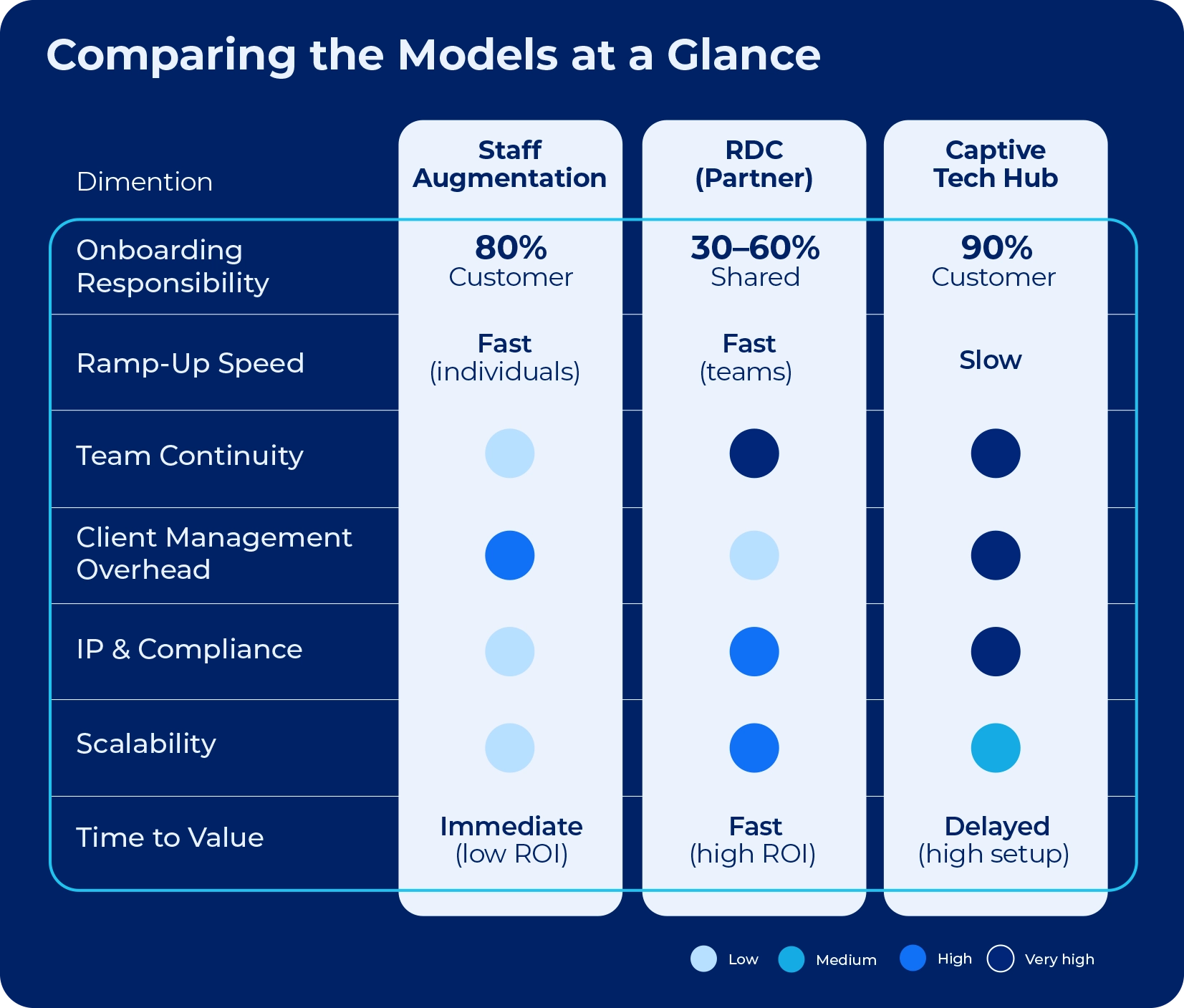As companies invest heavily in digital transformation, the question is not whether to nearshore – it is how to structure it.

Modern nearshore delivery services are so much more than cost savings and access to a wider talent pool, and this is simply because lower cost and higher capacity are no longer sufficient. Companies in Western Europe are seeking partners that deliver short delivery times, genuine expertise, and seamless collaboration, rather than mere vendors.
Therefore, understanding the operational models available is crucial for selecting the right one. Staff Augmentation, Remote Delivery Centers (RDC), and Captive Tech Hubs – each one of the most popular models offers different benefits in terms of client involvement, scalability, and strategic value.
Let’s have a closer look at these approaches through a client-centric lens.
Staff Augmentation
Staff augmentation is typically the go-to approach when a company needs, often reactively, a short-term scale-up or urgent bridging of skill gaps. With this model, businesses leverage external engineers’ expertise to expand their existing teams.
While a quick talent plug-in addresses immediate priorities and gives flexibility, such scaling is far from sustainable. The problem with staff augmentation is that the model is predominantly client-managed, and most of the onboarding, integration, and task allocation burden is on internal teams. In complex environments, it inevitably slows down delivery and requires formidable dedication from management and tech leads.
Indeed, staff augmentation gives the client high control, but it is not really a scalable, long-term solution for building resilient teams or achieving strategic goals.

Captive Nearshore Hubs
Captive centers are perfect for mature enterprises with long-term strategic goals, strong internal delivery governance and HR operations, and capacity to own their entire engineering capability. Companies that build and manage their own delivery centers, ideally in nearshore locations, have complete control over operations, governance, and knowledge management. End-to-end ownership and alignment, coupled with maximum knowledge retention, turn captive nearshore hubs into strategic platforms for innovation.
However, this approach is much more complex and time-consuming, which results in a slower ramp-up. As the client leads 90% (or even more) of operations and talent, running a captive center requires long-term investments in infrastructure buildout, recruitment, onboarding, and regulatory compliance. This means strategic fit is high, particularly in IP-sensitive or regulated domains, but so is the total cost of ownership.
Companies that build their own captive centers need sufficient in-house capabilities to manage remote operations as they have to deal with local hiring, HR, regulatory compliance, culture integration, etc. And if they lack the required experience in managing global delivery ecosystems, this inevitably becomes a massive undertaking and investment outweighs the benefit.

Remote Delivery Centers (RDC)
The Remote Delivery Center model can be best described as a hybrid approach that combines the strengths of the augmentation and captive models while eliminating their weaknesses. It is ideal for mid- to long-term delivery and boasts agility and control without compromising process stability.
A Remote Delivery Center is strategically managed by the partner, but closely aligned with the client’s tech stack, processes, objectives, and culture. Co-ownership of the delivery process brings maximum stability as dedicated, long-standing teams technically extend the internal teams – with vastly reduced management overhead. Meanwhile, the strategic partner is in charge of talent management, knowledge retention, and operational excellence.
Thanks to predefined delivery guidelines and infrastructure, ramp-up is very fast, and innovation and ownership excel due to high team continuity. While onboarding responsibility is mostly partner-driven, the customer retains strategic control without the overhead of running an internal hub. It is true that the client is still dependent on its partner’s maturity and expertise to some extent, but the balanced delivery responsibility typically results in high scalability and continuity and faster time-to-value.

Why RDC Is the Scalable Choice for EU Markets
Modern enterprises need more than lower cost and engineering talent – they need engineering capability, rooted in process maturity, domain expertise, and cultural compatibility.
At Scalefocus, our RDCs operate out of top-tier delivery hubs in Bulgaria, North Macedonia, and Turkey. These locations give us access to broad talent pools, multilingual proficiency, and proximity to Western European time zones. And while geography matters, it is Scalefocus’ delivery excellence that makes the big difference.
Scalefocus’ RDCs combine:
- Embedded Collaboration – our teams are fully aligned with your workflows
- Deep Expertise – we bring proven knowledge in highly regulated and innovation-heavy domains like BFSI, Energy and Utilities, Heathcare, iGaming, Aviation, etc.
- Seamless Integration, mature governance, and agile delivery frameworks
- Flexible engagement model that evolves as you grow
At Scalefocus, we help our clients by aligning delivery models with business outcomes and finetune RDCs for nearshore solutions’ success. Our approach offers the speed and scale that enterprises need, while reducing the operational burden that can potentially derail delivery initiatives.

Conclusion
Whether you’re scaling product delivery, modernizing legacy systems, or supporting internal transformation, how you deliver is just as critical as what you deliver.
Staff augmentation can help you plug gaps. Captives can give you full ownership. But if you are looking for speed, scale, and strategic value, Remote Delivery Centers give you the best of both worlds.
With an experienced partner such as Scalefocus, you are not simply outsourcing – you are expanding with purpose. Talk to our team to explore what model works best for your strategic goals.



